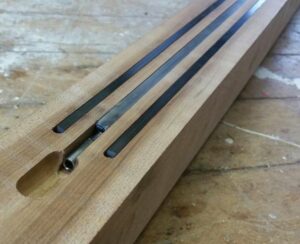Carbon Composite, Composite Rods and Tubes
Carbon Fiber Rods: Structural Composite Reinforcement
Engineers, equipment manufacturers, and product designers use carbon fiber rods and structural support components in a variety of industries. Because of their fantastic properties, like strength and rigidity, carbon fiber rods are an outstanding choice for applications where stiffness and weight are considerations.
How Pultruded Carbon Fiber Rods Are Manufactured
Carbon fiber rods are manufactured by a process called “pultrusion” – a portmanteau of the words “pulling” and “extrusion.” Extrusion is the pushing of material, like aluminum, through a shaped die. Pultrusion is the pulling of material, such as carbon fiber and resin, through a shaped die. In carbon rod pultrusion, continuous lengths of carbon fiber are pulled through a bath of resin and then through a heated die. The die forces the bundle of resin-wet fibers to conform to the die shape. The heated die cures the resin to set the bundle of fibers into its final shape. After the composite rod is pulled through the die, it is post-cured as it is pulled to the saw and cut to stock lengths.
Pultrusion is an excellent way to manufacture carbon fiber rods. For one thing, it’s a continuous, machine-led process that is efficient and cost-effective. Large runs of one carbon fiber rod profile can yield economies of scale. For another, the composite rods themselves have fantastic properties. The fibers are all oriented linearly along the rod, so the carbon fiber rod is incredibly strong in the longitudinal direction. This high axial strength allows the rods to evenly distribute force over its entire length. Carbon fiber rods are lightweight and have a high modulus of elasticity.
Carbon Fiber Rod Attributes

Carbon fiber rods are straight and rigid, making them ideal materials for frames and structural reinforcement. Because the carbon fibers run the length of the rod, they are an excellent choice for applications requiring bending and pulling. Carbon fiber rods make a great alternative to wood, PVC, steel, and aluminum – they are stronger, lighter, and more resistant to environmental factors than many other materials. Specifically, carbon fiber rods are fatigue resistant, corrosion resistant, and have low electrical conductivity.
Engineers and product designers choose pultruded carbon fiber rods because of the unique anisotropic characteristics, high strength-to-weight ratio, durability, and corrosion resistance. Rods are commonly used as structural support and carbon fiber rods are excellent alternatives to wood, metals, and other less efficient materials to improve overall product performance while reducing weight.
Carbon Fiber Rods in Industrial Machinery
Carbon fiber rods are perfect for frame construction and structural reinforcement in industrial machinery because of their high stiffness-to-weight ratio. Additionally, their fatigue resistance and low conductivity make carbon fiber rods ideal for applications with repeated stress and wear. For example, carbon fiber rods are used as wrap bars in the beverage packaging industry; the plastic film repeatedly stretches over the carbon rod and wraps around the flat of drinks. Industrial glass production uses carbon fiber rods as rollers in their manufacturing process; carbon fiber wears smoothly, thus protecting the glass as it rolls.
Carbon Fiber Rods in Musical Instruments

Luthiers (guitar builders) use carbon fiber rods as structural reinforcement in the necks of guitars. Flat carbon rods are installed in the necks of guitars to prevent warp, twist, and bowing of a thin, wooden neck while still allowing the use of a truss rod for precise relief adjustments. A guitar neck reinforced with carbon fiber will be more rigid and less prone to changing shape with changes in weather, humidity, temperature, or season.
Pipe organs builders and restorers use carbon fiber rods as trackers. Trackers are the mechanical linkage between keys and pedals pressed by the organist and the valve that allows air to flow into the pipes. These long carbon rods are repeatedly pulled, so fatigue resistance of the carbon fiber makes them ideal for this process.
Other Typical Applications
The uses of carbon fiber rods are wide, varied, and endless. Here are some typical applications:
- External fixators
- Robot arms
- Bow stabilizers
- Marine ribbing
- Rollers
- Guiders
- Ramrods
- Probes
- Truss rod reinforcement
- Trackers
- Drone frames
 Machining Carbon Fiber Rods
Machining Carbon Fiber Rods
Goodwinds Composites has a full-service precision machine shop customized to work with carbon fiber rods. We can custom cut to within .005” inch specification, as well as perform a variety of end processes such as chamfering, grinding, drilling, slotting, and more. Carbon fiber is a tough material to machine because it creates a fine dust that can negatively impact the performance of equipment like lathes and mills.
Get Started Today
Goodwinds Composites has thousands of composite rods and tubes in stock and ready to ship, including carbon fiber rods in round and flat profiles from .020” in diameter to .750” in diameter. We custom cut and machine to spec, so give us a call or send us an email today: 206-632-6151, [email protected].
